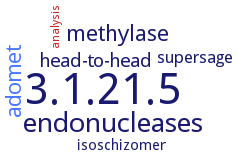3.1.21.5: type III site-specific deoxyribonuclease
This is an abbreviated version!
For detailed information about type III site-specific deoxyribonuclease, go to the full flat file.
Word Map on EC 3.1.21.5 
Reaction
endonucleolytic cleavage of DNA to give specific double-stranded fragments with terminal 5'-phosphates
=
Synonyms
ATP-dependent type III restriction endonuclease, BceSI, BsaHI, cj0031, EC 3.1.23, EC 3.1.24, EcoP1, EcoP15, EcoP15I, EcoPI, HinFIII, LlaFI, MmyCI, More, NgoAXP, PhaBI, PspGI, PstII, R.EcoP15I, R.MmyCI, REase, restriction endonuclease PstII, restriction-modification system, StyLTI, type III DNA restriction/modification enzyme, type III R-M enzyme, type III R/M enzyme, type III RE, type III restriction endonuclease, type III restriction enzyme, type III restriction-modification enzyme, type III restriction-modification system, type III RM system, type III testriction-modification enzyme, type III-like restriction endonuclease
ECTree
Crystallization
Crystallization on EC 3.1.21.5 - type III site-specific deoxyribonuclease
Please wait a moment until all data is loaded. This message will disappear when all data is loaded.
Please wait a moment until the data is sorted. This message will disappear when the data is sorted.
database information: http://rebase.neb.com
-
real-time imaging of enzyme at scan rates of 1-3 frames per s. EcoP15I translocates DNA in an ATP-dependent manner, at a rate of 79 bp/s, resulting in the accumulation of supercoiling. EcoP15I bound to its recognition site also makes nonspecific contacts with other DNA sites, thus forming DNA loops and reducing the distance between the two recognition sites
-
study of enzyme-DNA pre-cleavage complexes by atomic force microscopy. DNA loops observed are formed by a contact between site-bound EcoP15I enzyme and a nonspecific region of DNA, and do not result from translocation. Model for restricition by type III enzymes involving both structural elements, and a functional reason for the unusual site orientation required for the cleavage reaction
-



 results (
results ( results (
results ( top
top





